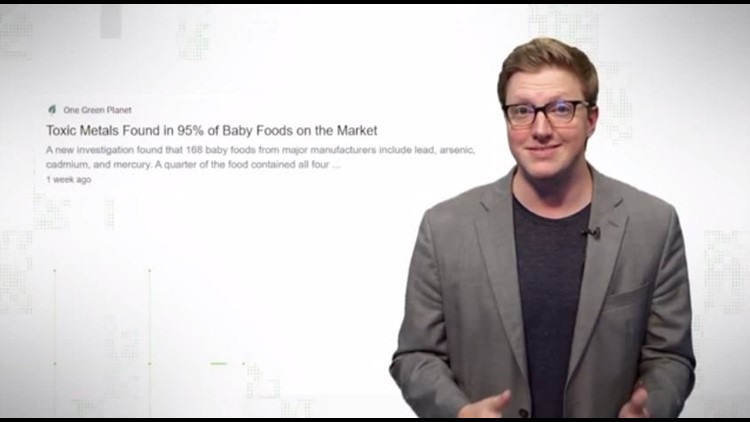Here is Part One of Jason Pucket’s Verify segment on potential misleading claims made in headlines that cite “studies” and “reports.”
It aired on Monday, Nov. 11. Part Two of the segment runs Tuesday in FOX43’s First and 4 and 5.
Here is a transcript of Part One:
Jackie De Tore, FOX43:
A scientific study led to some truly terrifying headlines in October.
95% of baby foods contain toxic metals or chemicals — and could be linked to lower IQ in children.
Alarming claims for sure. But were they true?
We’ve had our VERIFY team breaking this down — and explaining why the answer isn’t as simple as true or false.
Here’s our Jason Puckett.
Jason Puckett, VERIFY:
Headlines like this are frustratingly common.
“New study claims….”
“Report says…”
They attribute the information to a scientific study. But if you’re a parent, you’re not focusing on the word: “Study” or “Report” — you’re focused on 95% of Baby Foods are filled with Toxic Chemicals.”
That’s Freaky. It’s a terrifying claim and it doesn’t tell you what to do about it.
But the reality is that most of these headlines sit above pretty complicated articles.
And that’s partly because scientific research is complicated.
Read the actual articles — or better yet — read the actual research, and you’ll find that the reality is less “Study finds 95% of Baby Foods Contain Toxic Metals”…
And more:
“Study into about 150 popular baby foods found trace amounts of elements like lead. Some of those amounts were higher than the recommended safety levels put forth by the FDA and the scientists are calling for more research.”
Yeah. Side by Side. It’s pretty obvious why people pick this headline over this 38-word monstrosity.
But “flashy headline” doesn’t mean “good headline.”
A wordier one may not get clicks — but it could convey more accurate info and people might react more accurately too.
See, if you ask a research scientist, they’ll tell you that Scientific studies don’t actually determine FACTS.
Science is all about developing and testing theories.
It’s literally step one of the Scientific Method.
- Form a Hypothesis – or testable question.
- Perform a test and observe.
- Interpret the results.
- Draw Conclusions
- Publish your findings.
NASA breaks it down pretty well.
First you form a hypothesis – Or THEORY
And then — Steps two through four — YOU TEST IT.
Let’s make up one together.
Nicholette think’s she’s luckier than most people.
But she wants to prove it.
There’s the hypothesis: “Nicholette is luckier than the average person.”
So how do we test that. Well — let’s flip a quarter.
We know there’s a 50/50 chance of heads or tails.
So if Nicholette is luckier, she’ll land the side she calls more often.
(Test is shown. Nicholette says: “Heads.”)
We ran the test 100 times. Nichollette and I have almost identical results.
Did we definitively prove Nicholette wasn’t lucky? NO.
But we did get evidence that could lead to that conclusion.
And that’s science in a really basic form.
For most theories — like gravity — the tests are run and run and run and repeated thousands of times and the evidence continues to build.
BUT — things get a little confusing when you look at fields that are constantly changing: Like Dietary studies.
You know what I’m talking about.
1984 – Studies say eat less salt!
1990 – New Research says fat is bad for you!
So… Salt bad, Fat bad? Right.
NOPE.
2013 – New Research says you need more salt again!
And 2014 – Scientists say fat isn’t all bad! Eat more!
This is confusing.
But it’s part of how science works.
Our understanding of the human body and dietary needs changed between 1984 and 2013.
So did the research.
That doesn’t mean either study is definitively wrong.
We just have new understandings that change how we interpret their data.
But that’s the key takeaway when you read a headline like this:
“95% of baby foods contain toxic metals or chemicals — and could be linked to lower IQ in children”
Remember that one study’s results aren’t fact.
They could be true. They could be false.
Or some combo of both.
If it’s an important subject, look for more research into the claims.
The FDA told us this study does show the need for more research.
That takes time — but more evidence will help determine if a studies conclusions are accurate or not.
As we’re breaking down “studies” here — we’re gonna take a deep look at a flawed one.
(Headline: Chocolate can help with weight loss.)
Great headline but really questionable methods – and in our next piece we’ll show you why.
With your VERIFY, I’m Jason Puckett



